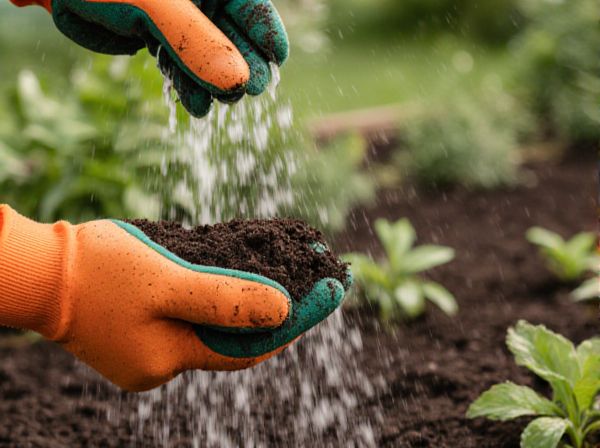
Soil drenching vs Foliar spraying Illustration
Soil drenching delivers pesticides directly to the root zone, ensuring systemic absorption and targeting pests beneath the soil surface, which is especially effective against root-feeding insects and soil-borne diseases. Foliar spraying applies pesticides to plant leaves, providing rapid pest control on above-ground insects and foliage diseases by creating a protective barrier. Choosing between soil drenching and foliar spraying depends on pest location, plant type, and desired speed of control for optimal pest management.
Table of Comparison
| Aspect | Soil Drenching | Foliar Spraying |
|---|---|---|
| Application Method | Applied directly to soil around plant roots | Sprayed onto plant leaves and stems |
| Pest Target | Soil-dwelling pests, root feeders, larvae | Above-ground pests like aphids, mites, and whiteflies |
| Speed of Action | Slower uptake via roots, longer effect duration | Rapid effect due to direct absorption by leaves |
| Frequency | Usually less frequent, depends on pesticide longevity | Often requires frequent application for effective control |
| Environmental Impact | Possible leaching and groundwater contamination | Risk of drift and non-target plant exposure |
| Effectiveness | Highly effective for systemic pesticides on root pests | Effective for contact pesticides on foliar pests |
| Cost Efficiency | Generally more cost-efficient for root pest control | May require more product and labor |
Understanding Soil Drenching and Foliar Spraying
Soil drenching involves applying pesticides or nutrients directly to the soil, targeting root uptake for systemic pest control and improved plant health. Foliar spraying delivers treatments onto the leaves, enabling rapid absorption and effective management of foliar pests and diseases. Selecting between soil drenching and foliar spraying depends on the pest type, target plant area, and desired speed of action for optimal pest management.
Key Differences Between Soil Drenching and Foliar Spraying
Soil drenching delivers pesticides or nutrients directly to the root zone, promoting systemic absorption and longer-lasting protection against soil-borne pests and diseases. Foliar spraying targets the leaves, offering rapid pest control and nutrient uptake but requiring more frequent applications due to surface wash-off and environmental factors. Key differences include uptake pathways, pest targeting efficiency, and application frequency, influencing choice based on pest type and crop conditions.
When to Use Soil Drenching for Pest Control
Soil drenching is most effective for controlling soil-dwelling pests such as root aphids, grubs, and fungus gnats by delivering insecticides directly to the root zone where pests reside. This method ensures systemic distribution of pesticides through plant roots, providing long-lasting protection against root infestations. Use soil drenching during early pest detection or preventive treatments in crops sensitive to root damage or when foliar sprays fail to reach subterranean pest populations.
When Foliar Spraying is Most Effective
Foliar spraying is most effective when pests or diseases primarily affect the above-ground parts of plants, such as leaves and stems, allowing for rapid absorption of nutrients and pesticides. It is particularly useful during periods of active growth when leaves are healthy and can readily absorb sprays, enhancing the efficacy against surface-feeding insects like aphids, mites, and whiteflies. Timing application in early morning or late afternoon minimizes evaporation and maximizes contact with target pests, boosting treatment success.
Advantages of Soil Drenching in Garden Pest Management
Soil drenching delivers pesticides directly to the root zone, ensuring systemic absorption and long-lasting protection against soil-borne pests and diseases. This method reduces the risk of pesticide runoff and minimizes damage to beneficial insects, supporting a healthier garden ecosystem. Effective for controlling root aphids, nematodes, and fungus gnats, soil drenching provides targeted pest management with improved efficiency compared to foliar spraying.
Benefits of Foliar Spraying for Gardeners
Foliar spraying delivers nutrients and pesticides directly to the plant leaves, enabling rapid absorption and faster pest control compared to soil drenching. This method reduces the risk of soil-borne diseases and minimizes chemical runoff, promoting a healthier garden ecosystem. Foliar spraying also allows precise application, conserving resources and improving overall plant health and growth efficiency.
Common Pests Targeted by Soil Drenching vs. Foliar Spraying
Soil drenching effectively targets root-feeding pests such as fungus gnats, root aphids, and nematodes by delivering systemic insecticides directly to the soil where these pests reside. Foliar spraying is ideal for combating foliar pests like aphids, whiteflies, spider mites, and thrips that feed on plant leaves and stems, providing immediate contact control. Understanding the feeding habits and location of common pests ensures optimal use of soil drenching or foliar spraying for effective pest management.
Step-by-Step Guide to Soil Drenching Application
Soil drenching involves applying a liquid pesticide or nutrient solution directly to the soil around plant roots, ensuring effective absorption and pest control below the surface. Begin by mixing the recommended concentration of the product in water, then evenly distribute the solution around the base of the plant, targeting the root zone to maximize penetration and efficacy. This method is particularly effective for managing soil-borne pests like nematodes, fungus gnats, and root aphids by disrupting their life cycle at the root level.
How to Properly Apply Foliar Sprays for Best Results
To properly apply foliar sprays for best results, use fine droplets to ensure even coverage on leaf surfaces while avoiding runoff. Apply sprays during early morning or late afternoon to reduce evaporation and maximize absorption by stomata. Consistently monitor weather conditions, avoiding application before rain or strong winds that can diminish efficacy and increase drift.
Choosing the Right Method: Factors to Consider for Your Garden
Soil drenching targets pests and diseases at the root zone by applying pesticide solutions directly to the soil, ensuring deep systemic absorption and longer-lasting protection. Foliar spraying delivers treatments to plant leaves, offering rapid action against surface pests but requiring more frequent applications due to environmental exposure. When choosing between soil drenching and foliar spraying, consider pest type, plant tolerance, environmental conditions, and treatment frequency to optimize pest control efficacy while minimizing plant stress.
Soil drenching vs Foliar spraying Infographic

 gardendif.com
gardendif.com